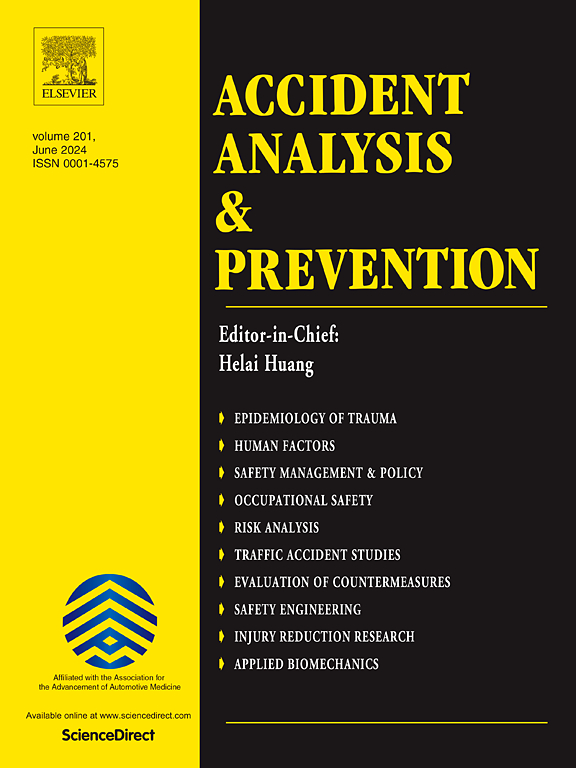Pedestrian crash causation analysis near bus stops: Insights from random parameters Negative Binomial–Lindley model
IF 6.2
1区 工程技术
Q1 ERGONOMICS
引用次数: 0
Abstract
Pedestrian safety remains a pressing concern near bus stops along urban transit, where frequent pedestrian–vehicle interactions occur. While prior research has primarily focused on intersections and midblock locations, bus stops have often been treated as secondary contributors rather than as distinct sites requiring targeted safety assessments. This has left a critical gap in understanding how traffic exposure, roadway characteristics, and bus stop design features specifically influence pedestrian crash risks around bus stop locations. To address these gaps, this study develops a comprehensive framework focused on pedestrian safety in the vicinity of bus stops. The proposed approach employs a Random Parameters Negative Binomial–Lindley (RPNB–L) model to account for unobserved heterogeneity and site-specific variability. Using data from 596 bus stops in Fort Worth, Texas (2018–2022), the model identifies that higher pedestrian crash frequencies are significantly associated with increased AADT, elevated boarding activity, and the absence of key safety elements such as crosswalks, medians, and lighting. Conversely, far-side bus stop placement, signalized intersections, sidewalks, and mixed-use development are associated with lower crash risks. Roads near schools and those with speed limits of 35 mph show elevated crash risk. To support proactive safety management, the study integrates a Full Bayes-based Potential for Safety Improvement (PSI) metric, enabling the identification of hazardous stops and high-risk corridors. By unifying advanced count-based modeling with strategic risk prioritization, this research offers actionable, data-driven insights for improving pedestrian safety near bus stops.
公交车站附近行人碰撞原因分析:来自随机参数负二项-林德利模型的见解
在城市交通沿线的公交车站附近,行人安全仍然是一个紧迫的问题,因为行人与车辆之间经常发生相互作用。虽然先前的研究主要集中在十字路口和街区中间的位置,但公交车站经常被视为次要因素,而不是作为需要有针对性的安全评估的独特地点。这在理解交通暴露、道路特征和公交车站设计特征如何具体影响公交车站周围行人碰撞风险方面留下了一个关键的空白。为了解决这些差距,本研究开发了一个全面的框架,重点关注公交车站附近的行人安全。该方法采用随机参数负二项林德利(RPNB-L)模型来解释未观察到的异质性和位点特异性变异性。该模型使用了德克萨斯州沃斯堡596个公交车站(2018-2022年)的数据,发现行人碰撞频率较高与AADT增加、乘车活动增加以及人行横道、中间线和照明等关键安全元素的缺失显著相关。相反,公交车站、信号交叉口、人行道和混合用途开发与较低的碰撞风险相关。学校附近的道路和限速≤35英里/小时的道路显示出更高的撞车风险。为了支持主动安全管理,该研究整合了基于全贝叶斯的安全改进潜力(PSI)指标,能够识别危险站点和高风险通道。通过将先进的基于计数的建模与战略风险优先级相结合,本研究为改善公交车站附近的行人安全提供了可操作的、数据驱动的见解。
本文章由计算机程序翻译,如有差异,请以英文原文为准。
求助全文
约1分钟内获得全文
求助全文
来源期刊

Accident; analysis and prevention
Multiple-
CiteScore
11.90
自引率
16.90%
发文量
264
审稿时长
48 days
期刊介绍:
Accident Analysis & Prevention provides wide coverage of the general areas relating to accidental injury and damage, including the pre-injury and immediate post-injury phases. Published papers deal with medical, legal, economic, educational, behavioral, theoretical or empirical aspects of transportation accidents, as well as with accidents at other sites. Selected topics within the scope of the Journal may include: studies of human, environmental and vehicular factors influencing the occurrence, type and severity of accidents and injury; the design, implementation and evaluation of countermeasures; biomechanics of impact and human tolerance limits to injury; modelling and statistical analysis of accident data; policy, planning and decision-making in safety.
 求助内容:
求助内容: 应助结果提醒方式:
应助结果提醒方式:


